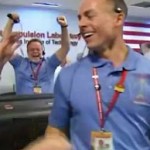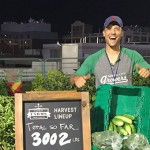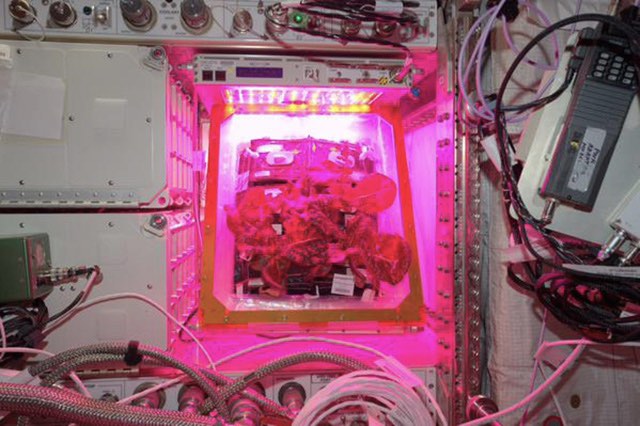Astronaut cuisine has always consisted mainly of freeze-dried foods, but now a freshly grown vegetable garden is taking off.
Astronauts aboard the International Space Station tweeted their excitement Sunday about an off-planet first: the next day’s menu would include veggies grown on board.
“Fun watching these (salad greens) grow,” astronaut Kjell Lindgren tweeted, as he shared the photo above. “Almost sad to eat them tomorrow. Almost.”
For weeks he and the rest of the crew had tended the ‘patch’ of “Outredgeous” red romaine lettuce. Though it was not the first crop cultivated in space, this time they were actually going to get to eat it.
SEE More Good News About NASA in the Good News Network Archives
“Lettuce take a #selfie,” crew mate Scott Kelly joked in his tweet. Behind him in the photo, fresh romaine leaves hover within a transparent box bathed in magenta light.
It is the classic image of science project–because that’s what it is.
Tomorrow we'll eat the anticipated veggie harvest on @space_station! But first, lettuce take a #selfie. #YearInSpace pic.twitter.com/fUKQMhEDjK
— Scott Kelly (@StationCDRKelly) August 9, 2015For decades, NASA and other space agencies have experimented with plants in space, but the results were always sent to earth for examination, rather than eaten. Likewise, half of this week’s crop will be withheld from the salad bowl and sent back to earth– just the latest results of ongoing experiments in zero-gravity gardening.
NASA’s aim with space farming, as it’s called, goes beyond the need to feed a few astronauts within the cramped confines of the International Space Station. With planned deep-space missions to an asteroid by 2025 and to Mars in the 2030s, NASA needs to figure out how to grow food not only aboard spacecraft, but also on other planets.
Field of Greens: Baseball Stadiums Grow Veggies on Roof to Feed Fans
The Veggie Plant Growth System that produced Monday’s momentous salad is “aeroponic,” designed to cultivate vegetation in an air or mist environment without soil. Even on earth, plants grown this way mature up to three times faster than those grown in soil and require far less water and fertilizer, NASA explained. Such plants are much less prone to disease and, sealed safely away from the world of bugs, never need pesticide.
Besides, NASA said, on-board gardening gives astronauts something fun to do during long missions, between their systems checks, spacewalks and other official duties.
We’re sure it tasted out of this world.
(READ more at CNN) — Photos: Kjell Lindgren, Twitter
SHARE the news with your space friends…




















